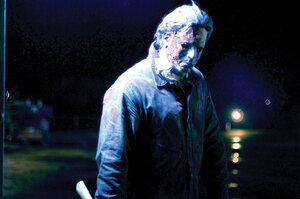Rob Zombie revitalizes gore of Halloweens past
Writer-director Rob Zombie possesses a lot of ambition that has yet to be perfected. His new film, Halloween 2, which itself is a sequel to his 2007 remake of John Carpenter’s 1978 slasher classic Halloween, clearly illustrates that while Zombie has a long way to go, he is certainly heading in the right direction.
Zombie’s latest remake picks up a few hours after the first film of the franchise ends — with the iconic mask-wearing killer Michael Myers presumed dead and en route to the morgue. But after a freak accident during transportation, Myers — who turns out to be very much alive — escapes custody.

Myers returns · Rob Zombie’s remake of John Carpenter’s 1981 classic, Halloween 2, features the return of the sociopathic Michael Myers. - Photo courtesy of The Weinstein Company
Then there is Laurie (Scout Taylor-Compton), one of the few survivors from the film’s predecessor who, even after a year, is still completely terrified and convinced that Myers will come back. The trauma from the first film has left her with horrible nightmares in which she witnesses Myers’ carnage repeatedly before she is murdered as well.
While some remain paralyzed from the horror of the previous film, others, primarily Dr. Sam Loomis (Malcolm McDowell), have been profiting from Myers’ exploits with the release of a book that chronicles Myers’ brutality.
Then, to everyone’s dismay, Myers comes back to town on Halloween night to finish what he started. From here, the bodies begin to pile up and the sadistic murder scenes continue to gain momentum; each one far more extreme than the one before it, almost to the point of exhaustion — emphasis on “almost,” only because there is something savagely surreal in the way Zombie directs Myers’ mayhem.
Zombie has a solid style for depicting brutality that few can replicate. His direction has a prominence here that is dominated by unique color schemes, surprisingly interesting angles and a raw expression that makes it all the more grisly.
The problem with this, as with many slasher films, is that it is not enough. No matter how provocative it may be for Myers to stab someone with a large kitchen knife, even capturing all of the terror considerably well, watching him do it more than 10 times to the same victim becomes incredibly tiring.
Each murder is taken to the extreme, and while it works in some instances, loading the entire film with this mantra does not. Less killing would have been better for the film. That would have given Zombie more time and energy to develop the other characters as well as the overall plot.
Nothing really happens in Halloween 2 — nothing new anyway. Myers comes back to town, kills a lot of people and tries to reunite his family by making contact with his long-lost sister — quite similar to his actions in the first film. Add that to almost wretched dialogue in some scenes that is way too stereotypically corny, and the narrative of the film as a whole does not add up to much.
Zombie attempts to focus much of his film on the notion of family and the psychological effects it always has on an individual’s personality, especially when that individual is mentally disturbed.
Some of the film’s more interesting scenes try to convey the psychological trauma Myers endures, and provide a much-needed break from the killing. This is another clever aspect of the film that shows promise, but, similarly to Zombie’s other fascinating attributes, it desperately needs further development.
Yes, Halloween 2 is a slasher film and there should be an emphasis on the slashing, but Zombie has the ability to make it much more than your typical slasher film. The fact that it only cuts at the surface is disappointing.
Zombie has talent; there is no doubt about it. His 2005 film The Devil’s Rejects highlights his ambitious style of filmmaking, which continues to improve, but again the lack of story and blatant overexposure of graphic violence get in the way of his ability to fully control his determination and talent.
But if Halloween 2 says anything about its director, it is that he will one day make a good film that will be able to tie up all loose ends while satisfying his lust for blood. The real question is, how many meager offerings will audiences have to stomach before he does?
